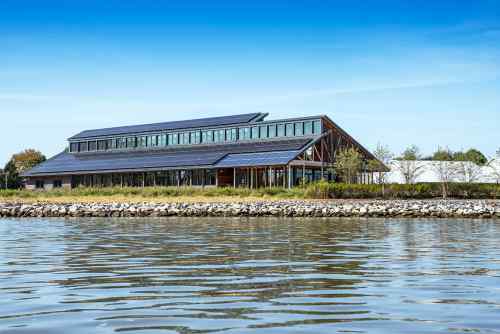Environmental Hall Dedication
The dedication of Semans-Griswold Environmental Hall, WC’s most innovative academic building to date, is set for Oct. 18 at the College’s waterfront campus on the Chester River.

Chestertown, MD—The dedication of Washington College's newest and most innovative academic building, Semans-Griswold Environmental Hall, is set for Oct. 18 at the College's waterfront campus on the Chester River.
The public is invited to the dedication, which begins at 5 p.m. The building's namesakes, Truman T. Semans and Jack S. “Jay” Griswold, will be honored at the event. Speakers include College President Kurt Landgraf, Maryland State Senate President Mike Miller, Maryland State Comptroller Peter Franchot, Center for Environment & Society Director John Seidel, and Larry Culp, former chair of the Board of Visitors and Governors.
The 11,500-square-foot Semans-Griswold Environmental Hall (SGEH) will be the new home for the Center for Environment & Society, as well as providing academic and lab spaces for the College's growing biology and environmental programs. Its very presence—located on a former brownfield site—is a statement to its purpose of supporting hands-on research on the Chesapeake and becoming a magnet for leadership centered on the environment and the challenges facing the region, the country, and the world.
Serving as a model for sustainable buildings, the new environmental hall has been designed and built to meet the rigorous standards of the Living Buildings Challenge (LBC). LBC focuses on building self-sufficient and regenerative buildings that connect occupants to nature while creating positive impacts on human and natural systems that interact with the structure. The new building is built to achieve certification on various LBC standards, chief among them in its net-positive energy use. It will rely solely on renewable energy sources and operate year-round in a pollution-free manner, producing at least 105 percent of its energy intake through a rooftop photovoltaic array of over 300 solar panels. Over a year, the building will push more energy into the grid than it removes.
Among its innovative design features is a state-of-the-art marine science lab that includes a river flow-through system, bringing ambient water from the Chester River to support a teaching and research lab. This will give faculty and students the unique ability to study river ecology and marine organism biology in a controlled environment. A Watershed Innovations Lab will serve as the home of Chester River Watershed Observatory. Here, students will be able to monitor water quality, deploy side-scan sonar to explore the river floor, construct autonomous underwater vehicles, and develop innovative processes that incorporate the latest technology in watershed science.
Semans-Griswold Environmental Hall will complement and enhance the College's diverse assets and powerful programming in the environment, including the interdisciplinary academic majors in environmental science and environmental studies and the biology major, the Chester River Field Research Station and its far-reaching projects and research, the 4,700 acres of living classroom at the River and Field Campus, the research vessels Callinectes and Lookdown, the Chesapeake Semester, and the new Eastern Shore Food Lab at Washington College.